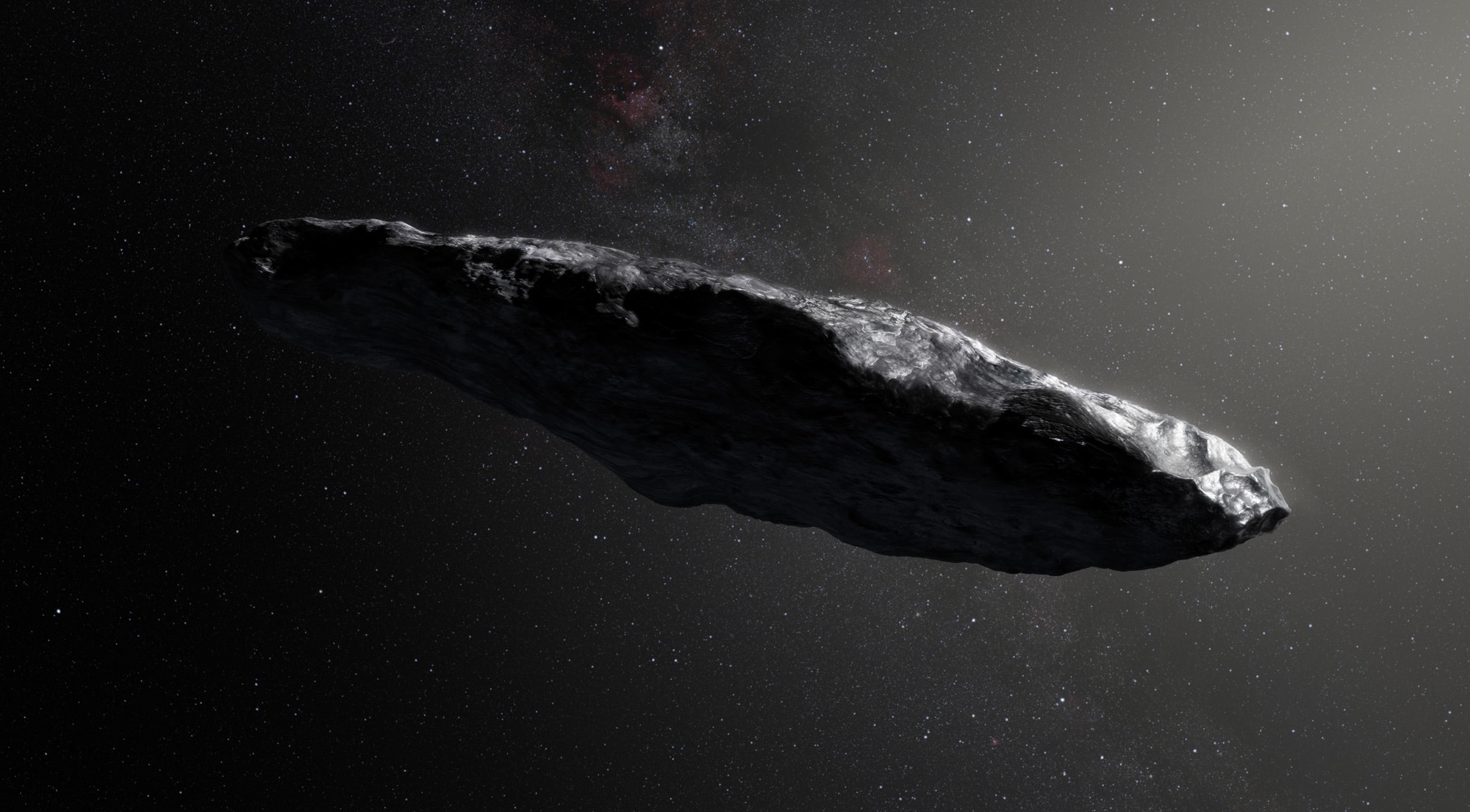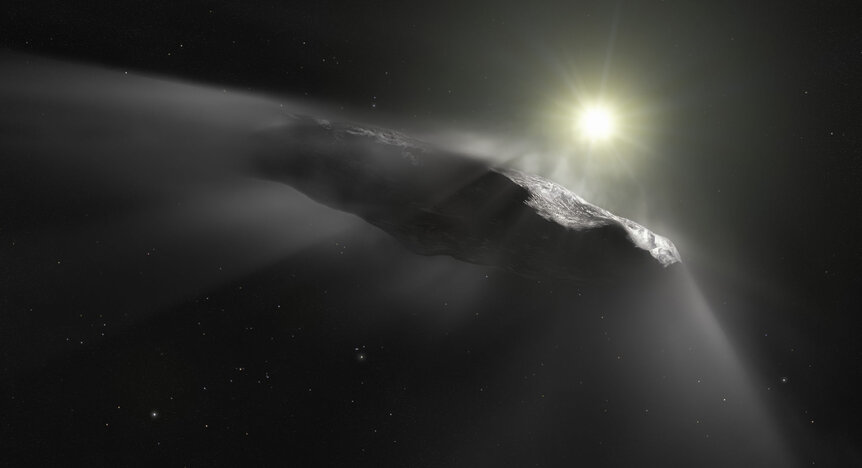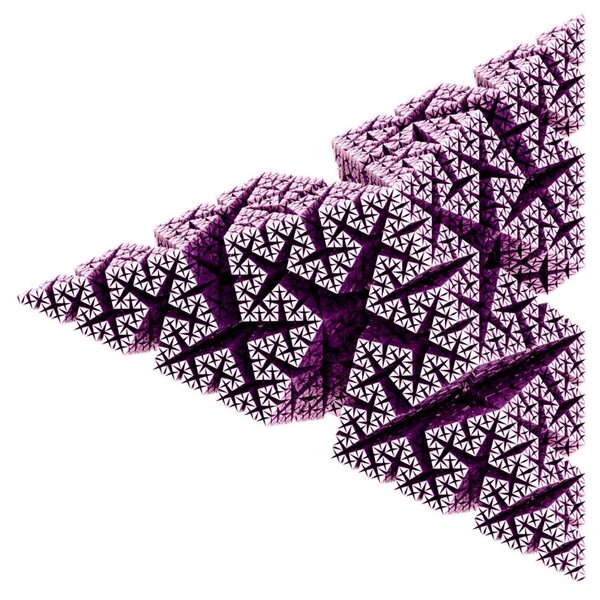Create a free profile to get unlimited access to exclusive videos, sweepstakes, and more!
No, 'Oumuamua is not an alien spaceship. It might be even weirder.

Not to put too fine a point on it, but what the frak is 'Oumuamua?
Oh, you remember 'Oumuamua. It caused quite a stir last year; first seen in late 2017 by the Pan-STARRS survey telescope in Hawaii, it was quickly found to have a very unusual orbit. Instead of the usual ellipse or circle around the Sun like normal solar system objects, it was found to have a hyperbolic orbit. That means it was moving too quickly to be bound to the Sun, and that, in turn, means it came from Out There. Like really out there: interstellar space, the void between the stars.
Subsequent observations confirmed it: 'Oumuamua was just passing through the solar system, with so much extra velocity (about 25 km/sec) that it was moving faster than the Sun's escape velocity. This was a one-time visitor, screaming through the solar system and heading back out into The Black once again.
That was certainly enough to make it the object of intense scrutiny. We'd never seen something from interstellar space pass through the solar system before! But what was it? At first it was classified as a comet, then an asteroid, and then maybe a comet again (this confusion is reflected in its provisional designations; at first it was A/2017 U1, for "asteroid", then C/2017 U1, for "comet", then finally I/2017 U1, for "interstellar"). It was hard to tell what it was; it was too small, faint, and far away to get good observations, and worse, it was only seen on its way out, so it was farther from us literally every day.
Then another very weird thing happened: More observations allowed a better determination of its trajectory, and it was found that it wasn't slowing down fast enough. As it moves away, the Sun's gravity pulls on it, slowing it down … but it wasn't slowing down enough.
Some force was acting on it, accelerating it very slightly. Comets are made of rock and ice, so maybe the ice was turning into gas, and as this was blown off it acted like a very gentle rocket. The problem with this is that no such venting was detected. If it were like comets in our solar system, you'd expect to see lots of carbon monoxide (CO) and carbon dioxide (CO2) coming from it, but none was seen. So maybe it was some other kind of ice, like water. But again, if it is like our local comets, it would take so much water that we'd have noticed.
That's when a couple of astronomers posited something interesting: Maybe this force was radiation pressure, literally the force of sunlight hitting it and giving it a tiny push. That makes some sense, but for the math to work out with the acceleration seen, 'Oumuamua had to be flat. Like, really flat: So thin that it looked more like a solar sail, a very thin sheet of material designed to catch sunlight and accelerate. But that, in turn, meant that 'Oumuamua was artificial. As in, a spaceship.
Besides the obvious (it seems like a big leap!), I have my problems with this idea. Not much has changed with that hypothesis since I wrote that, and while I wouldn't dismiss it being an alien probe out of hand, the evidence doesn't support that conclusion, and in fact points against it.
So, I ask again: What the frak is 'Oumuamua?
A new paper has come out that might have a solution, and it's really clever. Maybe 'Oumuamua's not flat. Maybe it's fluffy.
When the astronomers speculated it might be a thin and flat, giving it a large area like a sail, they had to assume a density for it. That's because the amount of pressure sunlight exerts is very small, so if an object is massive it has to be spread out very thin and big to catch enough sunlight to accelerate it enough to match the observations. So they assumed it had some normal density like 1 – 3 grams per cubic centimeter (roughly somewhere between the density of water to rock).
The new paper turns that around. Instead of assuming a density to find the area, let's assume the size determined using normal methods is correct, use that to get an area, and from there get the density needed to match the observations.
Assuming a size for 'Oumuamua of 50 – 130 meters, what they get is a very low density: About 0.00005 grams per cc. That's incredibly low, and at first it seems ridiculously so. That's 100 times less dense than air! No solid object could have a density that low!
… so what if it's not solid?
I'm not saying it's hollow, but maybe it's really porous. Like Styrofoam or Swiss cheese, but much much holey-er. Is there anything natural like that?
It turns out, surprisingly, yes. When stars are very young, they have a huge disk of material swirling around them; it's from this material that planets form. Out far from the star, where temperatures in the disk are cold, teeny tiny grains of dust and water ice can stick together in funny shapes, creating fractals. These are branching structures that aren't regularly spaced like crystals; instead they have a structure that's called self-similar: It looks the same no matter how much you zoom in or out. I know that sounds weird, but this video will help:
We see this a lot in nature, including in snowflakes. Materials made in a fractal pattern can be very porous, and in fact out in that protoplanetary disk around a young star, physical models show that objects can grow fractally until they're as big as ‘Oumuamua, and have those extremely low densities needed to account for its weird behavior.
So 'Oumuamua doesn't have to be a spaceship. It just has to be a snowflake! A three-dimensionally constructed phenomenally porous low-density snowflake.
And in fact this actually makes sense. The fact we see something like 'Oumuamua coming from interstellar space means we can try to estimate how many of them are out there at any time. Making some simple assumptions, the numbers you get are way too high to be explained by having the galaxy filled with such beasts. It seems far more likely that objects like 'Oumuamua are relatively rare, and that means it likely came from someplace close by (if it came from farther away, the odds are even lower we'd ever see one). Working out the math, the new paper suggests it came from a nearby star, and one that's relatively young (less than 100 million years). It formed out in the disk, and got ejected somehow, likely from a planet forming nearby giving it a boost from its gravity.
I have to say, I love this. It may not be as sexy or headline-grabbing as saying it's an alien probe, but it's very clever, it uses known materials and math, and the conclusion even fits in with what we know about how planets form. That makes it pretty dang cool in its own right. If I had to bet, I'd put a lot more money on this idea being correct over 'Oumuamua being an artifact from another civilization.
It may be we'll never know; it's moving pretty rapidly relative to us, and is very far away now — it's currently over 1.6 billion kilometers away. In a year it'll be 900 million km further. So it's not like we can catch up to it anytime soon.
We'll just have to wait for another such object … which, according to this new idea, may take a long time. But we're scanning the skies with better tech, seeing deeper, seeing fainter objects, all the time now. I certainly hope we find more beasties like this one. They can tell us so much about how planets form in other star systems, which is pretty hard to figure out from dozens or hundreds of light years away. It's a lot easier when they obligingly send bits of their building materials to us.
Get the latest news from SYFY WIRE delivered daily to the smart speaker of your choice. Learn how here.
















